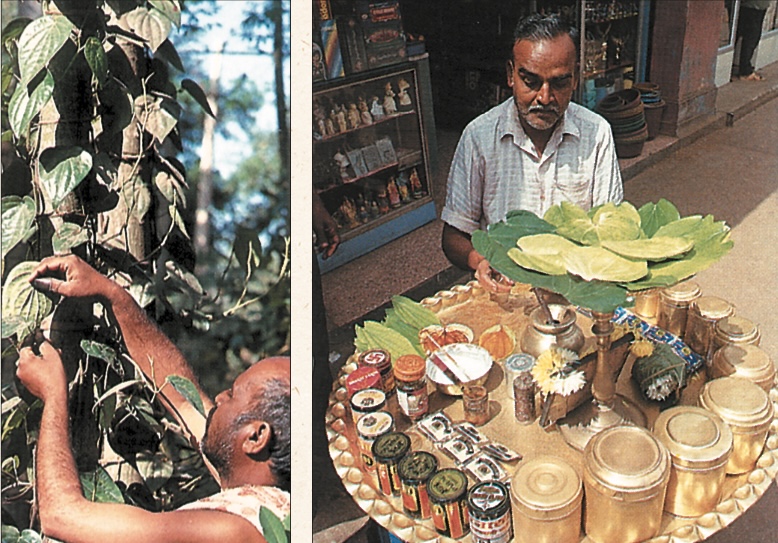With T. S. Satyan, India Perspectives
Take some shavings from an areca catechu nut off a palm tree and wrap it in a leaf of piper chavica betle from its famed spindly vine. Sprinkle on a little burnt lime with some catechu gum of a Malayan acacia tree and add a touch of nutmeg and cardamom for flavor. Now, chew all that until the red, potent juices start to flow. No folks, we’re not in West Texas and this ain’t tobacco. It’s “betel.” Although betel chewing has been one of India’s favorite culinary indulgences for more than 8,000 years, the betel leaf itself is also used in Hindu ritual worship, where it is prepared as an offering to the Deity along with coconuts, fruits, incense and flowers. Frequently referred to as paan or tambula, literally millions of Indians use it daily.
To offer tambula at an Indian social event is considered a sign of insider hospitality. In the Hindu ethos, paan is accepted as one of the bhogas (cardinal pleasures) of graceful living. During ancient times, being presented this tasty treat by a king implied an informal pledge of loyaltyand friendship. Betel is not only popular in India. It is also enjoyed throughout central Asia and China.
In his twelfth-century treatise, the Hitopadesa (“Book of Good Counsels”), Sage Narayana wrote, “The betel nut is bitter, hot, sweet, spicy, binding, alkaline. It is a demulcent, an astringent, a foe to the evils of the intestine, giving to the mouth a fragrance of breath, to the lips a crimson red, and for the heart a kindler of love’s flame. Praise to the Gods for the good betel!”
Abdul Razzak, a Persian traveller in the Kingdom of Vijayanagar in 1443 wrote, “This masticator lightens up the countenance. It relieves hunger, stimulates the organs of digestion and disinfects the breath.”
Vast plantations in India cultivate many varieties of betel. To the North, the Desi, Calcutti and Banarasi leaves are most favored. Prominent among the leaves from the South are the small and fragile chigurulaye of Karnataka, as well as the thicker, more popular ambadi and kariyale found in Tamil Nadu and Kerala.
In India, betel nut crackers and betel boxes that is, boxes containing betel leaf, areca nut and related spices are a feature among a rich man’s valuables. With their beautifully crafted and lacquered animal, bird and human motifs, these distinctly Indian artifacts, along with their matching plates, trays, cups and lime containers, are sought after by private collectors and museums. Each state in India revels in making its own special variety of betel boxes usually brass for the south and silver for the north.
Although betel chewing is healthy, in that it aids respiration and decreases the work load of the heart, the betel leaf itself contains a phenolic compound that has cocaine-like properties. For this reason it acts as a stimulant upon the central nervous system and produces a mild euphoria. Some US states restrict shipping of the leaves. It also contains an alkaloid called arecoline, which can usually due to excessive or immoderate use over a long period of time produce squamous cell carcinoma of the mouth, a form of skin cancer. Frequent use also stains the mouth, gums and teeth deep red, caused by the added catechu gum.
